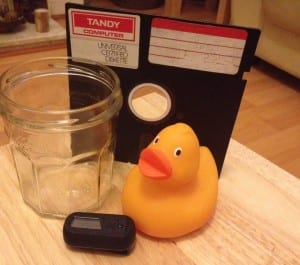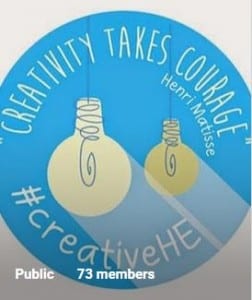
The course Creativity for Learning in Higher Education #creativeHE ticks a lot of my boxes. It’s about higher education in 21st century, teaching online, creative thinking, using social media, its open, free and above all is about the digital – which at the end of the day has always been my research and passion. This blog post is my cause memory jog as much as a reflection; a questions without answers approach. Online education supports postmodern bricolage styles of learning – much of which can go unrecorded so this is an attempt to catch some of the transient experiences.
I arrived a week late! Not the best of beginnings but a well thought out course like this from Chrissi Nerantzi can take it. A good course is like a dot to dot picture. Each dot is a link. A place to go. An activity to engage with. A paper to read. In my case I haven’t yet joined them up. But I don’t have to in order to participate and learn. I’ve been selective and this is typical of the student centred approach online learning environments have to support. Capacity for multiple approaches and pathways is essential. Online design needs a holistic structure where the parts really are greater than the whole. Teaching online is about facilitation (with a capital F), about providing a mix of opportunities and supporting exploration through them. Any online teacher who tries to replicate traditional face-to-face teaching practice is likely to fail. Any online student who expects to be taught will be disappointed.
Online courses also need to understand how digital ways of working are unique to each individual taking part. Digital literacies are like fingerprints and we all have our own distinctive styles of engagement. I haven’t done as much as others but I’m not looking for accreditation which maybe supports a more fractured level of engagement. For me this is a learning experience and within the first week I have learned the following:
- I may be less creative than I think.
- Creativity is a social construct.
- Online communication is open to a variety of interpretations.
The video by Jess Haigh demonstrated the power of multimedia for online introductions. I learned so much more about Jess from seeing and hearing her than from reading text. This was a creative approach I wanted to copy. It was interesting to see the response to my comment to the group ‘Would like to post a video too but hit barriers of place, time and noise levels (excuses!)’ . It appeared to be interpreted as lack of confidence rather than lack of opportunity and demonstrated the vagaries of online communication where we see what we think rather than what is being said.
I’ve skimmed some of the reading around creativity. My first thoughts are how it sits between the subjective and objective spheres. We might produce what we consider to be creative outputs but their acceptance depends on the interpretation of others. Through the course I picked up on the #twistedpair invitation from Steve Wheeler to make unlikely pairings and relate them to teaching and learning, in my case Klimt and the Venus of Willendorf. Whether this demonstrated creativity or not can be measured by likes and tweets – but in turn these are related to access parameters and the subjectivity of others. I’ve ended the week thinking much more about creativity as a social construct and how to ‘know’ if I’m a creative person or not; I suspect I may be less creative than I think!
I have learned a lot so far and this is why I do it. Evenings, weekends, early hours of the morning. I’m a learning addict but I also want to discover how the digital can support the student learning experience. The one thing I know for sure is the process is helped where staff who teach become online students themselves first.

Thought provoking and very honest reflections Sue. I often think the same that I’m not as creative as I think I am or that other people think I am. But then it all depends on what you believe is creative and if it is about bringing new things into existence that you value and perhaps changing something in your understanding as a result, then Lev Vygotsky himself would say you were creative. It seems to me the big issue is novelty ‘how new is what you have done?’ Is it only perceived as being creative by yourself, or by other people who have witnessed it? In the socially constructed world our creativity must lie on a spectrum from an audience of 1 to an audience of many. It only takes ourselves to recognise we have been creative but it requires many to recognise novelty.
Hi Sue,
So wonderful that you see value in participating in the course. Your reflections are very honest and invite for so many questions to be asked. I will just ask one here for now, at least 😉 and it has to do with facilitation especially online. How do you see this as different face-to-face and online, in the open and within a traditional online course perhaps?
Looking forward to your responses and let us know if you need any help connecting some of the dots, ok?
Enjoy the weekend,
Chrissi
Hello Chrissie
For me the difference between face to face and online is what I call the Pedagogy of Uncertainty – you never know what to expect! This includes the absence of interpersonal communication clues, not knowing if anyone will participate in your activities – and if not, why not. It can be exacerbated in open compared to a traditional online courses – participants might have a range of motivations outside your expectations, have less incentive to join in or to complete, with busy workloads it can be more difficult to prioritise something done voluntarily – these all make it challenging and exciting experiences – the pedagogy of Uncertainty is not necessarily negative – the unexpected can be incredibly positive – in particular with open online courses which offer opportunities to a broader audience and bring together people who might not have otherwise met. Opening up educational opportunities in this way is one of the huge advantages of being connected.
Sue 🙂
Another difference (I’ll write a blog post next week bringing these points together) is connected to time. While it takes longer to facilitate online courses (and develop them!) and students have to learn to be selective – reading what matters and not getting too distracted by the wonders of the internet (in itself a valuable digital literacy attainment) one of the advantages about learning and teaching online is everyone gets an opportunity to speak and be heard – it’s not like a face to face group but is more measured – there’s time for reflecting on and constructing replies – trying them out in Word or other text processing software then copying them across to Google+ when it feels they are ready. You can set alerts for all contributions and comments as they come in or if you are busy save them and read them all together at a chosen point during the day. The downside may be it privileges text fluency – and I guess this is where creativity comes in – looking at alternative ways to ‘speak’ online through image, audio, video etc